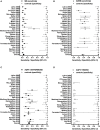Myelin Oligodendrocyte Glycoprotein: Deciphering a Target in Inflammatory Demyelinating Diseases
- PMID: 28533781
- PMCID: PMC5420591
- DOI: 10.3389/fimmu.2017.00529
Myelin Oligodendrocyte Glycoprotein: Deciphering a Target in Inflammatory Demyelinating Diseases
Abstract
Myelin oligodendrocyte glycoprotein (MOG), a member of the immunoglobulin (Ig) superfamily, is a myelin protein solely expressed at the outermost surface of myelin sheaths and oligodendrocyte membranes. This makes MOG a potential target of cellular and humoral immune responses in inflammatory demyelinating diseases. Due to its late postnatal developmental expression, MOG is an important marker for oligodendrocyte maturation. Discovered about 30 years ago, it is one of the best-studied autoantigens for experimental autoimmune models for multiple sclerosis (MS). Human studies, however, have yielded controversial results on the role of MOG, especially MOG antibodies (Abs), as a biomarker in MS. But with improved detection methods using different expression systems to detect Abs in patients' samples, this is meanwhile no longer the case. Using cell-based assays with recombinant full-length, conformationally intact MOG, several recent studies have revealed that MOG Abs can be found in a subset of predominantly pediatric patients with acute disseminated encephalomyelitis (ADEM), aquaporin-4 (AQP4) seronegative neuromyelitis optica spectrum disorders (NMOSD), monophasic or recurrent isolated optic neuritis (ON), or transverse myelitis, in atypical MS and in N-methyl-d-aspartate receptor-encephalitis with overlapping demyelinating syndromes. Whereas MOG Abs are only transiently observed in monophasic diseases such as ADEM and their decline is associated with a favorable outcome, they are persistent in multiphasic ADEM, NMOSD, recurrent ON, or myelitis. Due to distinct clinical features within these diseases it is controversially disputed to classify MOG Ab-positive cases as a new disease entity. Neuropathologically, the presence of MOG Abs is characterized by MS-typical demyelination and oligodendrocyte pathology associated with Abs and complement. However, it remains unclear whether MOG Abs are a mere inflammatory bystander effect or truly pathogenetic. This article provides deeper insight into recent developments, the clinical relevance of MOG Abs and their role in the immunpathogenesis of inflammatory demyelinating disorders.
Keywords: MOG; autoantibodies; demyelination; inflammation; myelin oligodendrocyte glycoprotein.
Figures

Similar articles
-
Myelin oligodendrocyte glycoprotein antibody-associated disease: an immunopathological study.Brain. 2020 May 1;143(5):1431-1446. doi: 10.1093/brain/awaa102. Brain. 2020. PMID: 32412053
-
Myelin-oligodendrocyte-glycoprotein (MOG) autoantibodies as potential markers of severe optic neuritis and subclinical retinal axonal degeneration.J Neurol. 2017 Jan;264(1):139-151. doi: 10.1007/s00415-016-8333-7. Epub 2016 Nov 14. J Neurol. 2017. PMID: 27844165
-
Myelin Oligodendrocyte Glycoprotein Antibody-Associated Disorders: Toward a New Spectrum of Inflammatory Demyelinating CNS Disorders?Front Immunol. 2018 Nov 29;9:2753. doi: 10.3389/fimmu.2018.02753. eCollection 2018. Front Immunol. 2018. PMID: 30555462 Free PMC article. Review.
-
Neuromyelitis optica spectrum disorders with aquaporin-4 and myelin-oligodendrocyte glycoprotein antibodies: a comparative study.JAMA Neurol. 2014 Mar;71(3):276-83. doi: 10.1001/jamaneurol.2013.5857. JAMA Neurol. 2014. PMID: 24425068
-
MOG Spectrum Disorders and Role of MOG-Antibodies in Clinical Practice.Neuropediatrics. 2018 Feb;49(1):3-11. doi: 10.1055/s-0037-1604404. Epub 2017 Aug 31. Neuropediatrics. 2018. PMID: 28859212 Review.
Cited by
-
Optical coherence tomography in myelin-oligodendrocyte-glycoprotein antibody-seropositive patients: a longitudinal study.J Neuroinflammation. 2019 Jul 25;16(1):154. doi: 10.1186/s12974-019-1521-5. J Neuroinflammation. 2019. PMID: 31345223 Free PMC article.
-
Myelin-Associated MAL and PLP Are Unusual among Multipass Transmembrane Proteins in Preferring Ordered Membrane Domains.J Phys Chem B. 2020 Jul 16;124(28):5930-5939. doi: 10.1021/acs.jpcb.0c03028. Epub 2020 Jun 4. J Phys Chem B. 2020. PMID: 32436385 Free PMC article.
-
Clinical Course, Imaging Characteristics, and Therapeutic Response in Myelin Oligodendrocyte Glycoprotein Antibody Disease: A Case Series.J Neurosci Rural Pract. 2020 Jan;11(1):205-210. doi: 10.1055/s-0040-1701371. Epub 2020 Mar 3. J Neurosci Rural Pract. 2020. PMID: 32140030 Free PMC article.
-
Respiratory virus-induced heterologous immunity: Part of the problem or part of the solution?Allergo J. 2018;27(3):28-45. doi: 10.1007/s15007-018-1580-4. Epub 2018 Apr 26. Allergo J. 2018. PMID: 32300267 Free PMC article. Review.
-
A Case of Myelin Oligodendrocyte Glycoprotein Antibody Disease in a Pediatric Patient: Clinical Presentation, Treatment Response, and Follow-Up Considerations.Cureus. 2024 Sep 30;16(9):e70518. doi: 10.7759/cureus.70518. eCollection 2024 Sep. Cureus. 2024. PMID: 39479073 Free PMC article.
References
-
- Pham-Dinh D, Mattei MG, Nussbaum JL, Roussel G, Pontarotti P, Roeckel N, et al. Myelin/oligodendrocyte glycoprotein is a member of a subset of the immunoglobulin superfamily encoded within the major histocompatibility complex. Proc Natl Acad Sci U S A (1993) 90(17):7990–4.10.1073/pnas.90.17.7990 - DOI - PMC - PubMed
-
- Brunner C, Lassmann H, Waehneldt TV, Matthieu JM, Linington C. Differential ultrastructural localization of myelin basic protein, myelin/oligodendroglial glycoprotein, and 2′,3′-cyclic nucleotide 3′-phosphodiesterase in the CNS of adult rats. J Neurochem (1989) 52(1):296–304.10.1111/j.1471-4159.1989.tb10930.x - DOI - PubMed
Publication types
LinkOut - more resources
Full Text Sources
Other Literature Sources
Miscellaneous

